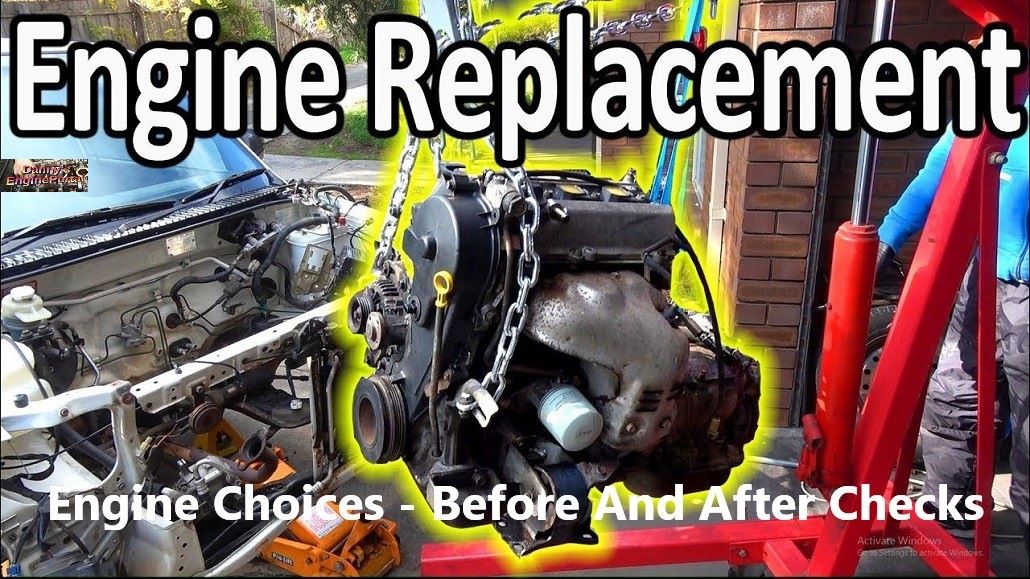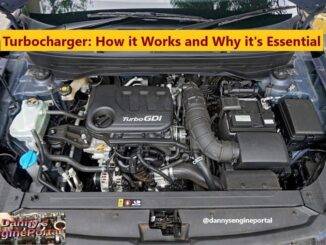
So, engine replacement is one of the more difficult tasks, a mechanic may ever face.
Because, engine replacement, requires different approaches for every year, make and model.
Above all, engine replacement, is much more complicated than simply pulling the old engine, and bolting up a fresh one. But, if your vehicle is in relatively good shape, engine replacement makes more sense, than replacing the vehicle.
First, because engine replacement can be challenging, I would suggest getting a service manual, specific to your vehicle. Above all, knowing what caused the engine to fail, is the first step in any repair. So, anytime you’re replacing an engine, you need to work methodically, to get it right the first time.
So, don’t be afraid to go to an expert for help. As a result, it will save you a lot of time, money and headaches in the long run.
If your old engine had 150,000 miles on it, then so do all the other parts like:
- Power steering
- Air conditioner
- Cooling system
- Charging system
- Starting system
- Transmission
- Sensors and relays
So, odds are they all need to be replaced, or at least tested. Because, if you ignore these basic tips, there’s no guarantee you won’t be facing, constant repair bills.
While the process may be different from vehicle to vehicle, some elements of an engine replacement, are fairly universal.
Here are some of the basic things that should be done or checked, before replacement:
- Check the motor mounts. Worn, loose or cracked, motor mounts, need replacing.
- Check the condition of the clutch or torque converter, transmission, CV joints, U-joints, etc. Then, make any repairs needed.
- Some items on the engine such as, manifolds brackets, accessories, spark plugs, oil filters, sensors, etc. Will probably be easier to install on the engine, while it is still out of the vehicle.
- Preassemble as much as you can, then finish the rest of the items, once the engine is in place.
- Install new oxygen sensor(s) (o2). Also, highly recommended, on high-mileage engines. As a result, to guarantee proper fuel feedback control, good fuel economy and emissions compliance.
- Install new belts and hoses (also, check automatic tensioners and idler pulleys and replace as needed).
- Install a new coolant temperature sensor (CTS) and thermostat. Also, highly recommended, to reduce the risk of overheating and possible engine damage.
- Install new spark plugs, plug wires, distributor cap and rotor (if equipped).
- Scan the computer for any fault codes, and fix problems as needed. Finally, clear any codes in the memory.
- Check for any (PCM) flash updates, that may be available from the (OEM). Then, re-flash the computer as needed.
- Check for any engine related technical service bulletins (TSB), that are out on the vehicle. And, make any upgrades or changes as recommended.
Engine replacement options include:
- Used Engines
- Repaired, Rebuilt Engines
- Reman Engines
- New Crate Engine
Used Engines
So, a used engine is one that was likely, pulled out a vehicle that was wrecked. And, had damage to another one of its mechanical systems, that ended up sending the vehicle to the junk yard. However, just because it’s been in a vehicle wreck, doesn’t mean it’s no good. Used engines are often a good choice. And, are cheaper, compared to a brand new one.
The engine most likely, doesn’t have a lot of miles on it. And, didn’t need to have any parts replaced. So, this is often the cheapest method of replacing an engine, if one can be found.
Repaired, Rebuilt Engines
A rebuilt engine, like a used engine, was pulled out of a vehicle. But, it has had some parts replaced. It was likely stripped, cleaned and put back together. Along, with any parts that needed to be updated, and new gaskets throughout. And, when done properly, a rebuilt engine can last for hundreds of thousands of miles.
Reman Engines
So, the highest quality option for engine replacement in your car, truck or SUV, involves a reman engine. This means that an engine, was returned to factory condition.
Machining of the block, crank and heads, along with bearings and other parts, to restore their specs. Then, that engine operates as if it was, brand new. And, it usually comes, with an added warranty. So, it will likely last longer, than a used or rebuilt engine. But, they will cost more up front.
New Crate Engine
So, a new engine uses all new parts. Including an, engine block, crankshaft, cylinder heads, connecting rods, camshaft, pistons, and valves. Because of this, a new engine will cost, a lot more than a reman engine.
So, as you can see there are many options available to you. And, each has their own features and benefits. As a result, do your research and make the right choice.
Some pre-installation inspection tips, for any engine replacement:
- Inspect the entire engine thoroughly. If there is an issue, you want to find out, before you have it installed.
- Match the replacement one with your old one. Make sure they are, exactly the same.
- After you have the old engine out, set it next to the used engine. Then, identify which components, need to changed over.
- If you find damaged components in your inspection (timing cover, oil pan, etc.). Then, swap the components from your old engine.
- Don’t install a replacement salvage engine, with damaged parts. As a result, this may cause the used engine, to fail prematurely.
- Inspect all the timing components on the engine. For instance, if miles are over the factory specs for a timing belt or chain, then replace the timing components.
- Best practice is to always, replace the timing belt. It’s a lot easier to do, when the engine is already out of the vehicle.
- Inspect all gaskets, and bolt on accessories. Then, replace any gaskets, that look brittle or are leaking. Finally, change over any bolt on accessories needed, off your old engine.
Conclusion
So, if your engine is nearing the end of its useful life. You may wonder whether to, rebuild or replace it. As a result, the warranty available, could play a role, in what type of engine you choose.
Remember, you’re going to need to pay for more than just the engine itself. So, even if you have the skills required for engine replacement. The process and parts itself, can cost several hundred dollars.
BY DANNY BENDER




